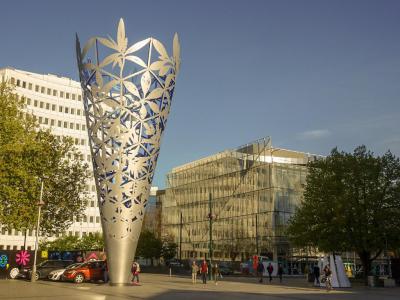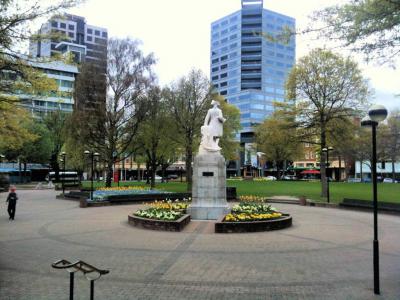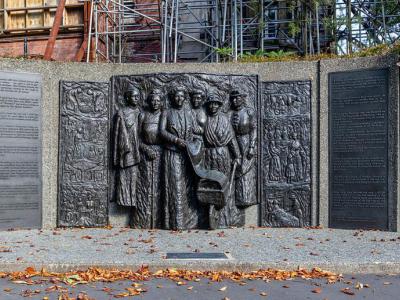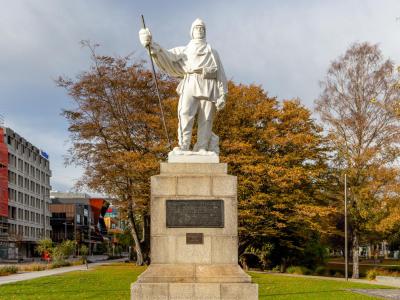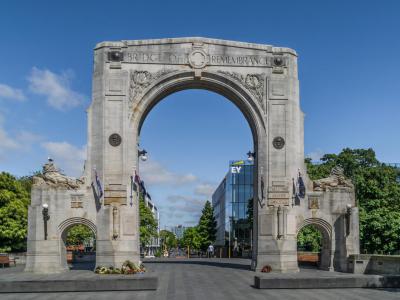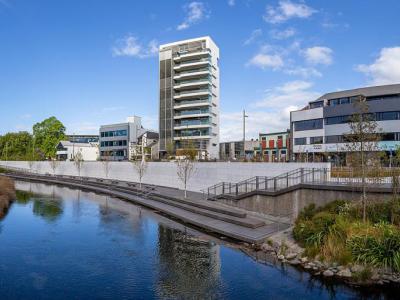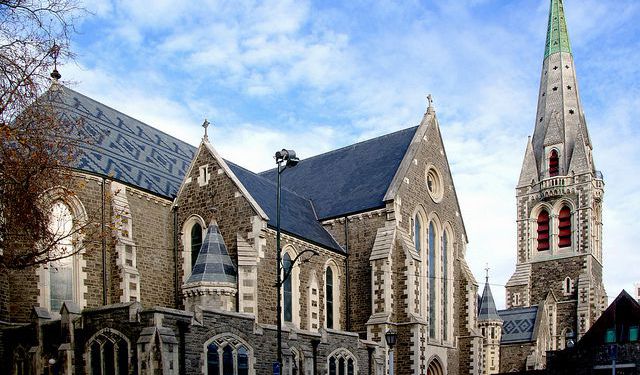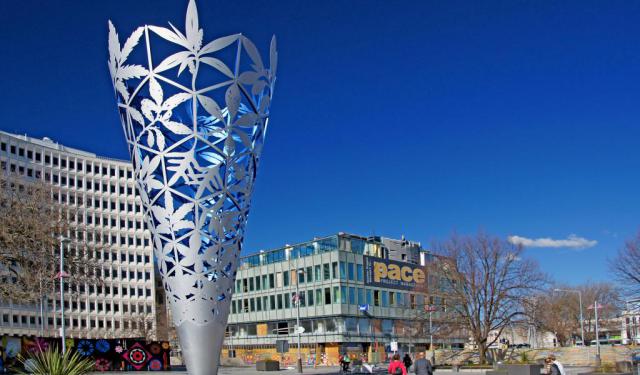
Statues and Memorials Tour (Self Guided), Christchurch
Although Christchurch is not very large, it has a wealth of public art heritage. Although ravaged by a powerful earthquake in 2011, which caused severe damage to many local attractions, Christchurch nonetheless has retained much of its charm and has a lot to offer visitors in terms of sightseeing. Indeed, there is no shortage of beautiful buildings, parks, gardens and other places of interest here.
Throughout its history, the city has accumulated a wide range of historically important monuments, commemorative statues and otherwise notable sculptures. The majority of Christchurch's most significant public art works are sited within the four Avenues area in the central part of the city. Here are some of them:
Victoria Square – formerly known as Market Square, back in the day this was where many Māori people used to bring their produce to sell on the banks of the Ōtākaro (Avon) River; now home to the statue of Queen Victoria whose reign fell upon the period of British global imperial expansion;
Kate Sheppard Memorial – observes the 100 years since New Zealand women won the right to vote, in 1893;
Statue of Robert Falcon Scott – a marble monument memorializing the death of Scott and his party on their return from the South Pole in 1912; sculpted by Scott's widow, Kathleen, and unveiled in 1917;
Bridge of Remembrance – A war memorial erected by the citizens of Christchurch in 1923 to initially honor those fell in WWI, but then extended to those who participated in both World Wars and in subsequent conflicts in Borneo, Malaya, Korea and Vietnam.
For a more detailed acquaintance with these and other sculpted landmarks of one of New Zealand's major cities, take this self-guided walking tour.
Throughout its history, the city has accumulated a wide range of historically important monuments, commemorative statues and otherwise notable sculptures. The majority of Christchurch's most significant public art works are sited within the four Avenues area in the central part of the city. Here are some of them:
Victoria Square – formerly known as Market Square, back in the day this was where many Māori people used to bring their produce to sell on the banks of the Ōtākaro (Avon) River; now home to the statue of Queen Victoria whose reign fell upon the period of British global imperial expansion;
Kate Sheppard Memorial – observes the 100 years since New Zealand women won the right to vote, in 1893;
Statue of Robert Falcon Scott – a marble monument memorializing the death of Scott and his party on their return from the South Pole in 1912; sculpted by Scott's widow, Kathleen, and unveiled in 1917;
Bridge of Remembrance – A war memorial erected by the citizens of Christchurch in 1923 to initially honor those fell in WWI, but then extended to those who participated in both World Wars and in subsequent conflicts in Borneo, Malaya, Korea and Vietnam.
For a more detailed acquaintance with these and other sculpted landmarks of one of New Zealand's major cities, take this self-guided walking tour.
How it works: Download the app "GPSmyCity: Walks in 1K+ Cities" from Apple App Store or Google Play Store to your mobile phone or tablet. The app turns your mobile device into a personal tour guide and its built-in GPS navigation functions guide you from one tour stop to next. The app works offline, so no data plan is needed when traveling abroad.
Statues and Memorials Tour Map
Guide Name: Statues and Memorials Tour
Guide Location: New Zealand » Christchurch (See other walking tours in Christchurch)
Guide Type: Self-guided Walking Tour (Sightseeing)
# of Attractions: 6
Tour Duration: 1 Hour(s)
Travel Distance: 1.4 Km or 0.9 Miles
Author: Nikki
Sight(s) Featured in This Guide:
Guide Location: New Zealand » Christchurch (See other walking tours in Christchurch)
Guide Type: Self-guided Walking Tour (Sightseeing)
# of Attractions: 6
Tour Duration: 1 Hour(s)
Travel Distance: 1.4 Km or 0.9 Miles
Author: Nikki
Sight(s) Featured in This Guide:
- Chalice Sculpture
- Victoria Square
- Kate Sheppard Memorial
- Statue of Robert Falcon Scott
- Bridge of Remembrance
- Canterbury Earthquake National Memorial
1) Chalice Sculpture
While a student at Hastings Boys' High School in New Zealand, Francis Neil Dawson launched his art career by painting "April Fool" in white on the roof of the school. Years later he climaxed his penchant for art in public places by creating The Chalice, an enormous, upside down metallic cone in Cathedral Square in Christchurch.
Dawson's forte is optical illusions assisted by the use of patterns, like moire. The Chalice, also called The Millennium Cone, is a steel and aluminum sculpture. It was commissioned for the 150th anniversary of Christchurch and Canterbury by the Canterbury Association in 2001.
The sculpture is of aluminum on a hexagonal steel framework. Forty-two aluminum leaves of native plants are woven through the honeycombed steel. The native tree species represented are Mapou, Kowhai, Mahoe, Totara, Karamu, Titoki, Maratata and Koromiko. The Cone is 59 feet high. The base diameter is 6.5 feet. Top diameter is 28 feet.
The base of the sculpture is dark granite with a diameter of ten feet. The cone is painted silver on the outside and blue inside. At night it may be lighted inside and out.
Dawson's forte is optical illusions assisted by the use of patterns, like moire. The Chalice, also called The Millennium Cone, is a steel and aluminum sculpture. It was commissioned for the 150th anniversary of Christchurch and Canterbury by the Canterbury Association in 2001.
The sculpture is of aluminum on a hexagonal steel framework. Forty-two aluminum leaves of native plants are woven through the honeycombed steel. The native tree species represented are Mapou, Kowhai, Mahoe, Totara, Karamu, Titoki, Maratata and Koromiko. The Cone is 59 feet high. The base diameter is 6.5 feet. Top diameter is 28 feet.
The base of the sculpture is dark granite with a diameter of ten feet. The cone is painted silver on the outside and blue inside. At night it may be lighted inside and out.
2) Victoria Square
Victoria Square was at first, Market Square. Maori people came to this area on the banks of the Avon River to market their produce. A 20-foot high totem was erected on the square in 1994. It was carved by artist Riki Manuel. It memorializes the presence of the first people.
Victoria Square was the commercial dynamo of early Christchurch. It held the Post Office, various markets, the Police Station, Women's Prison, an animal pound, store houses and Immigration Barracks. In May of 1903 the statue of Queen Victoria was unveiled in Market Square and the square became Victoria Square.
In March 1852 a simple bridge was erected over the Avon River. It was called the Market Place Bridge. It was replaced in 1864 by a bridge of iron and stone which still stands today. It was named Victoria Bridge. In 1989 it was renamed Hamish Hay Bridge.
Near the statue of Queen Victoria is Mana Motuhake, carved by Fayne Robinson. It honors the signing of the Treaty of Waitangi, which settled British and Maori governance of New Zealand. It consists of two upright canoe hulls (waka) holding carved figures mounted on a stone plinth.
Other monuments include the Floral Clock, using 7,000 plants each spring and autumn and the H.L. Bowker Fountain, designed by Victor Dean in 1931. Finally there is the marble statue of Captain James Cook, made by William Trethewey, commemorating his three voyages to New Zealand.
Victoria Square was the commercial dynamo of early Christchurch. It held the Post Office, various markets, the Police Station, Women's Prison, an animal pound, store houses and Immigration Barracks. In May of 1903 the statue of Queen Victoria was unveiled in Market Square and the square became Victoria Square.
In March 1852 a simple bridge was erected over the Avon River. It was called the Market Place Bridge. It was replaced in 1864 by a bridge of iron and stone which still stands today. It was named Victoria Bridge. In 1989 it was renamed Hamish Hay Bridge.
Near the statue of Queen Victoria is Mana Motuhake, carved by Fayne Robinson. It honors the signing of the Treaty of Waitangi, which settled British and Maori governance of New Zealand. It consists of two upright canoe hulls (waka) holding carved figures mounted on a stone plinth.
Other monuments include the Floral Clock, using 7,000 plants each spring and autumn and the H.L. Bowker Fountain, designed by Victor Dean in 1931. Finally there is the marble statue of Captain James Cook, made by William Trethewey, commemorating his three voyages to New Zealand.
3) Kate Sheppard Memorial
On September 19, 1893 New Zealand became the first independent country in the world to recognize women's right to vote. On September 19, 1993 The Kate Sheppard Memorial was unveiled to honor the life of one of the country's leading campaigners for women's suffrage, Kate Sheppard.
Sheppard organized multiple petitions to Parliament for granting women the right the right to vote. She wrote a pamphlet called "Ten reasons why the women of New Zealand should vote to support the campaign". Despite the defeat of suffrage bills in Parliament in 1888, 1891 and 1892, she continued the campaign. Her petition in 1893 received 32,000 signatures. The success finally came in the Electoral Act 1893 giving New Zealand women the right to vote.
The memorial is a life-sized bronze relief of Kate Sheppard and five other women leaders. The sculpture is in the form of a triptych. Sheppard and the women are in the center panel. Panels on each side depict scenes of women's lives at the end of the 19th century. The entire piece is 16 feet wide and six feet, seven inches high.
The women shown in the center panel beside Sheppard are: Helen Nicci, a suffrage activist; Ada Wells, a fighter for girls' education; Harriet Morison, an agitator for working women; Meri Mangakahia of Dei Tai Tokerau, petitioner of the Maori Parliament for women's rights; and Amey Daldy, of the Auckland Woman's Christian Temperance Union.
The memorial was designed by New Zealand artist Margriet Windhausen and it is located in the Kate Sheppard National Memorial Reserve. The reserve is by the Avon River near the corner of Worcester Street and Oxford Terrace.
Sheppard organized multiple petitions to Parliament for granting women the right the right to vote. She wrote a pamphlet called "Ten reasons why the women of New Zealand should vote to support the campaign". Despite the defeat of suffrage bills in Parliament in 1888, 1891 and 1892, she continued the campaign. Her petition in 1893 received 32,000 signatures. The success finally came in the Electoral Act 1893 giving New Zealand women the right to vote.
The memorial is a life-sized bronze relief of Kate Sheppard and five other women leaders. The sculpture is in the form of a triptych. Sheppard and the women are in the center panel. Panels on each side depict scenes of women's lives at the end of the 19th century. The entire piece is 16 feet wide and six feet, seven inches high.
The women shown in the center panel beside Sheppard are: Helen Nicci, a suffrage activist; Ada Wells, a fighter for girls' education; Harriet Morison, an agitator for working women; Meri Mangakahia of Dei Tai Tokerau, petitioner of the Maori Parliament for women's rights; and Amey Daldy, of the Auckland Woman's Christian Temperance Union.
The memorial was designed by New Zealand artist Margriet Windhausen and it is located in the Kate Sheppard National Memorial Reserve. The reserve is by the Avon River near the corner of Worcester Street and Oxford Terrace.
4) Statue of Robert Falcon Scott
Scott had been to Antarctica before 1910. In 1901 he and his team had attempted to reach the south pole for the British National Antarctic Expedition. Ernest Shakleton's Nimrod Expedition had also made the attempt between 1901 and 1910. Both expeditions had failed. Now, in 1910, with his Terra Nova Expedition, Scott would try again.
Scott and his team reached the pole on January 12, 1912, only to find that Roald Amundsen with his Norwegian team had beaten them to the pole by 33 days. On their return journey, Scott and all his men perished.
Scott's widow, Kathleen, a gifted sculptor and artist, was commissioned to create a statue memorial of her husband. The year was 1915. The war was raging and bronze was out of the question. Instead she used Carrara marble. The statue was unveiled on the corner of Worcester Street and Oxford Terrace in 1917.
The statue showed Scott standing tall, facing north. The team was headed north at the time of their deaths. A plaque in the plinth carried a quote from Scott's journal: "I do not regret this journey, which shows that Englishmen can endure hardships, help one another and meet death with as great fortitude as ever in the past."
The statue was toppled from its plinth in the 2011 earthquake. It had broken in several places. It was restored and unveiled again on October 6th, 2017.
Scott and his team reached the pole on January 12, 1912, only to find that Roald Amundsen with his Norwegian team had beaten them to the pole by 33 days. On their return journey, Scott and all his men perished.
Scott's widow, Kathleen, a gifted sculptor and artist, was commissioned to create a statue memorial of her husband. The year was 1915. The war was raging and bronze was out of the question. Instead she used Carrara marble. The statue was unveiled on the corner of Worcester Street and Oxford Terrace in 1917.
The statue showed Scott standing tall, facing north. The team was headed north at the time of their deaths. A plaque in the plinth carried a quote from Scott's journal: "I do not regret this journey, which shows that Englishmen can endure hardships, help one another and meet death with as great fortitude as ever in the past."
The statue was toppled from its plinth in the 2011 earthquake. It had broken in several places. It was restored and unveiled again on October 6th, 2017.
5) Bridge of Remembrance
Edward George Wright, civil engineer, was commissioned to build a bridge over the river Avon at Cashel Street in Christchurch in 1873. The bridge became pedestrianized in 1977 and it links Oxford and Cambridge Terraces over the Avon. In 1919, as World War I ended, Mrs Wyn Irwin, secretary of the Bridge of Remembrance Committee, wrote to The Press suggesting a memorial arch on the bridge.
The Memorial Arch was unveiled by Lord Jellicoe, hero of the Battle of Jutland, in November 1924. Soldiers crossed over the Avon this way in the Great War, on their way to the railway station and then by ship to the front.
The design was by William Gummer. Gummer had designed other memorials including the Dunedin Cenotaph war memorial. The central frame of the Remembrance Bridge memorial has the inscription "Quid non-pro Patria" ("What will a man not do for his country"). The arch is adorned with a cross, torches, coat of arms, laurel wreaths and stone lions.
On April 2, 1985 the Bridge of Remembrance was listed as a Category I with the New Zealand Historic Places Trust.
The Memorial Arch was unveiled by Lord Jellicoe, hero of the Battle of Jutland, in November 1924. Soldiers crossed over the Avon this way in the Great War, on their way to the railway station and then by ship to the front.
The design was by William Gummer. Gummer had designed other memorials including the Dunedin Cenotaph war memorial. The central frame of the Remembrance Bridge memorial has the inscription "Quid non-pro Patria" ("What will a man not do for his country"). The arch is adorned with a cross, torches, coat of arms, laurel wreaths and stone lions.
On April 2, 1985 the Bridge of Remembrance was listed as a Category I with the New Zealand Historic Places Trust.
6) Canterbury Earthquake National Memorial
The Canterbury Earthquake National Memorial can be found on both sides of the Avon River, downstream of the Montreal Street Bridge. There was a call for "Ideas to Remember." What was needed was "A place where people can spend time in reflection..." Slavonian architect Grega Vezjak's design filled the bill.
The memorial should: 1) Honor the 185 people who died; 2) Give thanks for those who helped in rescue and recovery; 3) Permit people to share experiences; 4) Provide a space for an annual gathering on 22 February and other events; and 5) become a point for contemplation and remembering. The Memorial has done all these things.
The memorial is designed to provide two different areas on either side of the curving Avon River. A space of parkland is on the north bank. It has trees, seating and gardens. Across the river on the south bank is the memorial wall with the names of those who died. The Maori name for the memorial is "Oi Manawa", "tremor of the heart."
Nondescript forms of concrete in the river remind one of the destructive tectonic forces of the earthquake. Water flows between and around these forms. The water of the river flowing by evokes the violence of the quake and the oppressive silence that followed.
There is a simple balance in the design, creating a feeling of sadness and loss. One can sit quietly, listening to the sounds of nature.
The memorial should: 1) Honor the 185 people who died; 2) Give thanks for those who helped in rescue and recovery; 3) Permit people to share experiences; 4) Provide a space for an annual gathering on 22 February and other events; and 5) become a point for contemplation and remembering. The Memorial has done all these things.
The memorial is designed to provide two different areas on either side of the curving Avon River. A space of parkland is on the north bank. It has trees, seating and gardens. Across the river on the south bank is the memorial wall with the names of those who died. The Maori name for the memorial is "Oi Manawa", "tremor of the heart."
Nondescript forms of concrete in the river remind one of the destructive tectonic forces of the earthquake. Water flows between and around these forms. The water of the river flowing by evokes the violence of the quake and the oppressive silence that followed.
There is a simple balance in the design, creating a feeling of sadness and loss. One can sit quietly, listening to the sounds of nature.
Walking Tours in Christchurch, New Zealand
Create Your Own Walk in Christchurch
Creating your own self-guided walk in Christchurch is easy and fun. Choose the city attractions that you want to see and a walk route map will be created just for you. You can even set your hotel as the start point of the walk.
Christchurch Introduction Walking Tour
Captain James Cook was not the first person to discover New Zealand. There is evidence that the Christchurch area was visited by groups of moa-hunting people as early as 1250 AD.
They were followed by the Waitaha from the east coast of the North Island in the 16th century. In a series of wars Waitaha were displaced by the Ngati Mamoe, who in turn were conquered by the Ngai Tahu. The Europeans... view more
Tour Duration: 2 Hour(s)
Travel Distance: 3.9 Km or 2.4 Miles
They were followed by the Waitaha from the east coast of the North Island in the 16th century. In a series of wars Waitaha were displaced by the Ngati Mamoe, who in turn were conquered by the Ngai Tahu. The Europeans... view more
Tour Duration: 2 Hour(s)
Travel Distance: 3.9 Km or 2.4 Miles
The Most Popular Cities
/ view all
